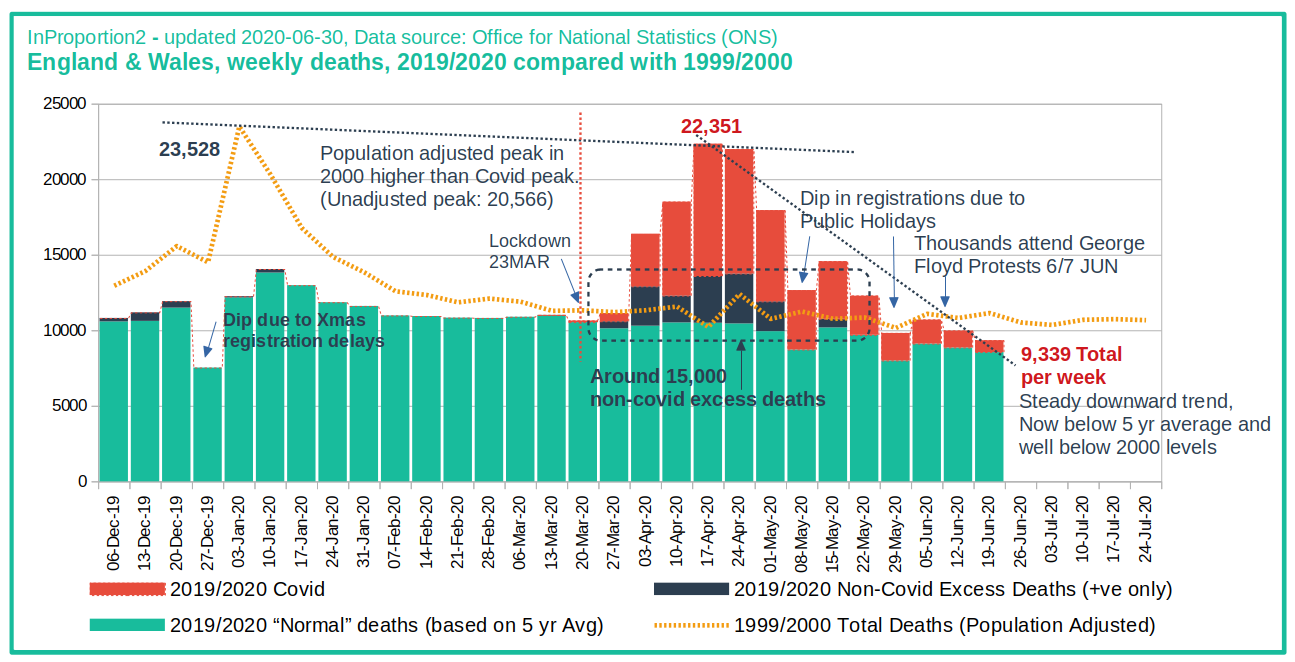
Lockdown has strained society to the limit
Lockdowns are immensely costly. The UK Government has already planned to spend around £132 billion in the current fiscal year, which is very close to the total annual budget of the National Health Service. [1]
This planned financial expenditure of course does not cover the unplanned spending and immense non-financial costs - for example, those that will be paid by the estimated 60,000 cancer patients who could die unnecessarily because of a lack of treatment or diagnosis, [2] just as one example of many categories of 'collateral damage' from the lockdown.
Sweden is a case study that many hate
Nearly every country has adopted a stricter form of lockdown than Sweden. If Sweden's approach should prove reasonably successful, it would indicate that other governments have made mistakes of historic proportion. Of course, governments will do everything to avoid appearing in error to such a degree, as will those in the media who urged them on.
The recent headlines shown here give a flavour of the hysterical antipathy often expressed towards Sweden. But is the negativity justified? Was the Swedish approach reasonably successful or not?

Comparing countries on the basis of Covid-19 deaths is flawed
The media has promoted the idea that Sweden has performed badly because of a high number of Covid deaths per million of population compared to its neighbours. One problem with this is that different countries may have different policies on what should be counted as a Covid death. As NHS Doctor Dr Malcolm Kendrick has recently stated:
"If a person who is 85 drops dead, what do you put on the certificate? I do this, so I know it is not very accurate. GPs were advised to put Covid-19 on the certificate if they suspected somebody had it, even if there was no test done"

Dr Malcolm Kendrick [3]
During March, April and May in England and Wales, there were around 15,000 deaths that would not normally happen at this time of year and that were not diagnosed as Covid deaths.[11] Opinions differ on what proportion of these were undiagnosed covid deaths and how many were 'collateral' deaths - unforeseen consequences of lockdown measures. Whatever the case, it must be wrong to ignore these deaths when making comparisons between countries.
In the US 'probable cases' have been included in test-positive numbers. This refers to individuals 'anecdotally matching the symptoms of COVID-19 but lacking an actual test' - this means that if you live in a certain location and have a cough, you may be counted as a Covid case.[4]
Can we be certain that the testing approaches adopted in differing countries are really comparable - if tests are even performed? When a country records a Covid death does it make the same distinctions as another when deciding whether a person died with Covid or of Covid?
Are the tests reliable and counted consistently?
The Norwegian Health Authority advises the public that as many as 14 out of 15 tests for Covid may be false positives. If that sounds unbelievable, check the reference below for yourself. [5]
In the UK the government recently needed to reduce the test-positive count [7] by 30,000 due to double counting, while in Ireland authorities have announced that Covid deaths have been overstated by around 55%. [8]
Recently Torsten Engelbrecht, co-author of the 2006 book Virus Mania, wrote in a well-referenced article: [6]
"Though the whole world relies on RT-PCR to 'diagnose' Sars-Cov-2 infection, the science is clear: they are not fit for purpose"
Using 'excess deaths' for comparison is problematic
Many authorities recommend the use of 'excess deaths' as a basis for comparing countries, but this approach has its problems; see discussion in notes below. [9]
Importantly, the use of excess deaths as a measure contributed to the panic around Covid when April 2020 was compared to previous Aprils, and found to be 'off-the-scale' bad. Had more emphasis been placed on comparing Covid with normal flu seasons (which are finished by April), Covid might have been better understood as something comparable to a bad flu outbreak - and responses to it might have been more proportionate.
Sweden might appear to have a higher figure for Covid deaths per million because it failed to lockdown OR because it has a different approach to testing, diagnosis and reporting OR because the test itself is flawed OR for some other unforeseen reason.
If instead of Covid deaths per million, we instead base comparisons on overall 'all-cause' mortality, these concerns go away. After all, one death is one death in any country, regardless of policy, practice or test efficacy - and is simple to count.
Conclusion 1: Looking at simple 'all-cause' mortality is a better basis for country comparisons as differences in testing, diagnosis and reporting will not impair or invalidate comparisons.
Comparing Sweden with the rest of the Nordic region using overall mortality
In the following comparisons, Scotland - Norway and Denmark's neighbour - has been included as an honorary Nordic country. Like Sweden, it has suffered badly from Covid, and as seen in the following table is in many respects comparable to the traditional 'Nordic' countries:

Deaths per week
First of all, we can look at the overall deaths per week. Covid can be seen to have a clear impact on overall mortality for Sweden and Scotland. For the other countries it is hardly visible. Notice how, until Covid deaths start to have impact, Sweden has lower deaths per million than most of its neighbours. Scotland suffered high mortality at the start of the year as well as during the Covid outbreak.
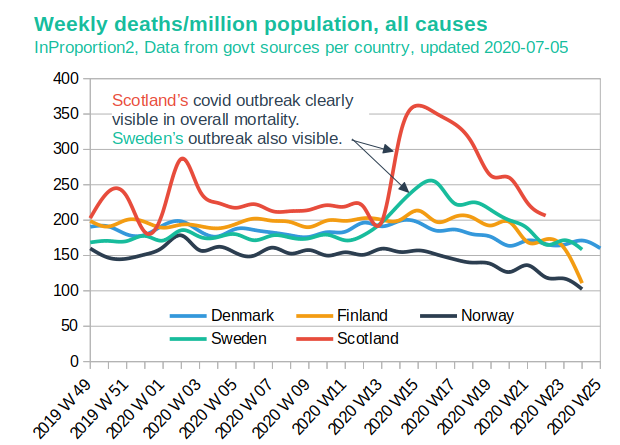
Cumulative deaths
A cumulative total shows that both Scotland and Finland have suffered higher overall mortality than Sweden.
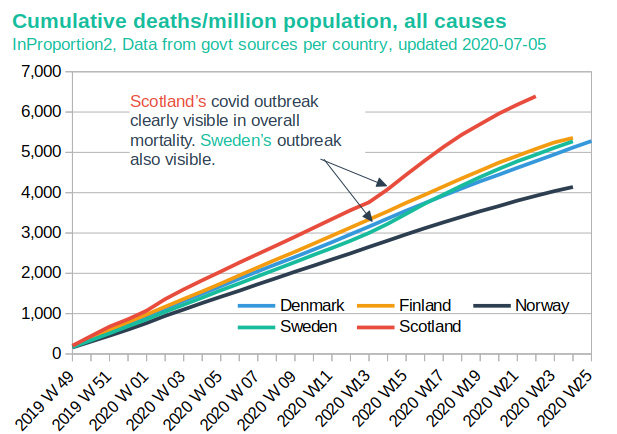
Zoom in on cumulative deaths
If we zoom in on the above graph, we can see how Sweden starts the year with lower mortality than Denmark. Then, as Covid shows an impact, Sweden's mortality rises above that of Denmark, but remains lower than that of Finland and Scotland.
Sweden's overall mortality is very close to that of both Finland and Denmark

Conclusion 2: In terms of all-cause mortality, Sweden is seeing a better outcome for 2019/2020 than Finland and Scotland, and is very close to Denmark.
Does lockdown severity correlate with overall mortality? Do other factors?
Going to work or not
Using Google's published mobility data, we can get an impression of how severe the lockdown was in each country. Plotting this against deaths per million, we can see that people in Scotland avoided work the most, and that Scotland saw the worst overall mortality. People in Sweden attended their workplaces more than residents of the other countries.
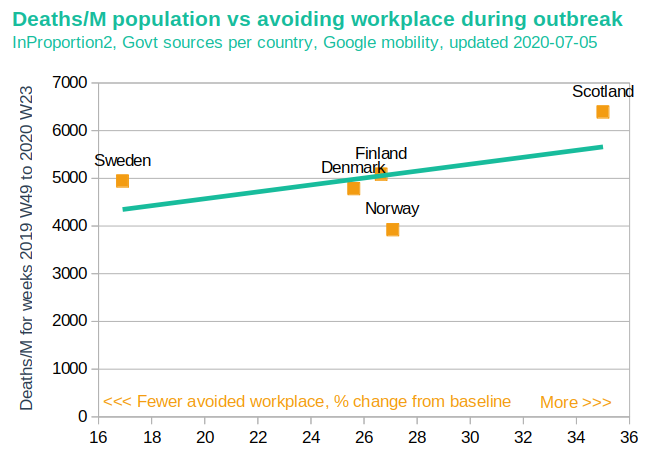
Staying at home
Here we can see that people in Scotland stayed at home the most, and had the worst overall mortality. Swedes stayed at home less than the Finnish, and had a better outcome.
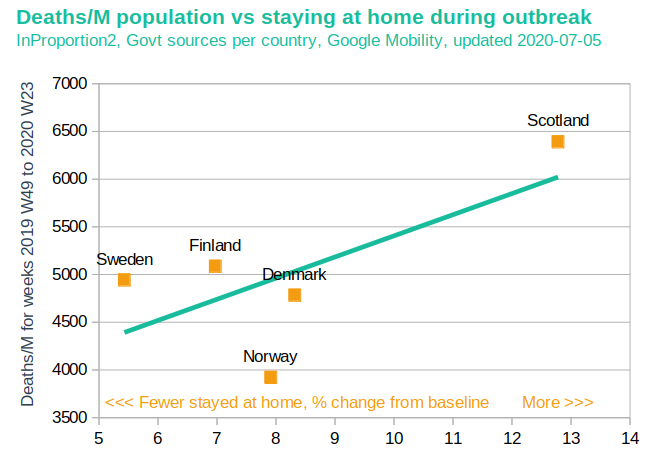
Living in the city
Population densities can be misleading. Sweden for example has a relatively low figure for population density due to its huge land area, despite the fact that many people live in densely populated cities. As an alternative, this chart shows the proportion of people living in the country's two largest cities.
No clear correlation is apparent here.

Age of population
Here we look at the proportion of the population aged over 64. Unsurprisingly, there is a clear correlation between age and overall mortality. If we exclude Scotland from the chart, the line through the other countries would be a reasonably straight one.
It may be that differences in the age structure of the population explain the differences in Covid mortality as well as any other factor.
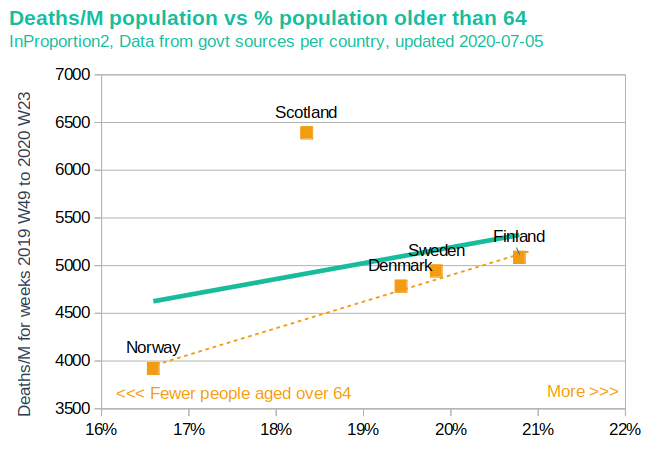
Conclusion 3: Severity of lockdown does not seem linked to a good outcome in 'all-cause' mortality in 2019/2020.
Sweden had the least severe lockdown, and has had a better outcome than Finland and Scotland.
Scotland had the strictest lockdown, and did the worst of all compared with its neighbours.
Case study: Öresund
The Öresund region is a bi-national metropolitan area that spans Denmark and Sweden, sometimes called 'Greater Copenhagen'. As such, it provides a relatively homogenous population spanning two different lockdown policy zones. If lockdowns were indeed effective, this would be the perfect place for that to be revealed in the data.
The data reveals that the lockdown on the Swedish side of the region did not provide an overall reduction in Covid deaths per million of population.
Twitter user FrankfurtZack provides the details:
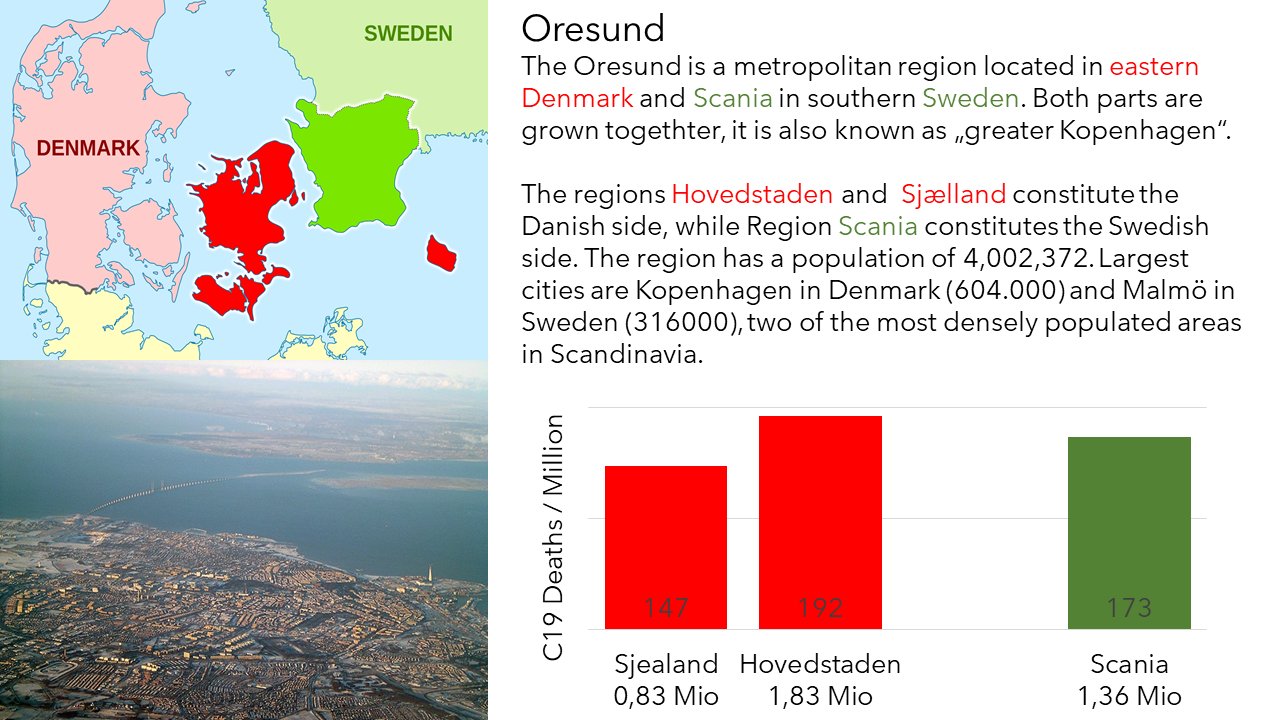
Overall conclusions: Overall mortality in Sweden is better than that of Finland and Scotland, and very close to that of Denmark.
Comparisons of Covid deaths per million in the Nordic countries made in the media are unreliable.
The hostility and negativity of the media towards Sweden's approach to Covid is unjustified, harmful and deeply irresponsible.
Notes and sources:
-
[1]
-
[2] The potential impact of COVID-19 on cancer mortality in the UK, Professor Karol Sikora, 6 May 2020
-
[3] "The lockdown is causing so many deaths", Dr Malcolm Kendrick in Spiked, 26 June 2020
-
[4]
-
'Probable' coronavirus deaths now included in CDC totals, The Hill, 16 April 2020
-
To emphasise the unreliability of Covid numbers, here is an interview with Nicola Sturgeon, First Minister of Scotland, where she explains "If you die of say a stroke, but you also happen to have the virus, you will be included in the deaths from Covid." She speaks for Scotland, and of course there is no guarantee that other countries are adding to the Covid death total so freely.
-
Sturgeon Challenged Over Care Home Deaths, order-order.com, 31 May 2020
-
-
[5] According to the Norwegian Health Authority
-
"High probability of false positive results where there is low transmission in society. When testing people with a very low risk of being infected, the majority of positive results will be false positive. Therefore, the positive answers are not so reliable.
-
With a prevalence of 0.01 per cent (as in Norway today), the positive predictive value would be around 7 per cent with today's PCR test (sensitivity 80 per cent and specificity 99.9 per cent). That is, 14 out of 15 who test positive are not infected with SARS-CoV-2."
-
Test criteria for coronavirus, Norwegian Health Authority, 29 June 2020
-
-
[6]
-
The quotes comes from a well-referenced article COVID19 PCR Tests are Scientifically Meaningless, Torsten Engelbrecht and Konstantin Demeter, Off-guardian, 27 June 2020
-
Torsten Engelbrecht co-wrote the book Virus Mania: How the Medical Industry Continually Invents Epidemics, Making Billion-Dollar Profits at Our Expense - a title which intrigues at the current time.
-
-
[7] "The methodology for reporting positive cases changed on 2 July 2020 to remove duplicates within and across pillars 1 and 2, to ensure that a person who tests positive is only counted once. Due to this change, 30,302 previously reported cases were removed from the UK total." Announced by the UK Government on 3 July 2020 coronavirus.data.gov.uk
-
[8] "Excess deaths 'substantially' less than Covid-19 figures - HIQA", rte.ie, 3 July 2020
-
[9] Using excess deaths as a measure introduces uncertainty
-
Some country comparisons emphasise 'excess deaths' as a basis. Typically this means looking at the number of deaths that happened compared to those expected. This approach has a number of problems:
-
Excess deaths can be calculated in different ways. The Oxford Centre for Evidence-Based Medicine recently calculated UK excess deaths varying from 31,417 to 54,000 depending on the method used. Others have used a ten-year average instead of the more standard five-year average, again giving very different results.
-
Monthly excess numbers will compare Covid's peak in April 2020 and a 'typical' April, when comparable flu outbreaks have already passed. A comparison of Covid and a flu outbreak might be more useful.
-
-
[10] Data Sources
-
[A] Deaths from 2019 week 49 up to 2020 week 23
-
Sweden: www.scb.se
-
Norway: www.ssb.no
-
Finland: pxnet2.stat.fi
-
Scotland: www.nrscotland.gov.uk/
-
Spain (not used): www.ine.es
-
-
[B] Population
-
Scotland: National Records of Scotland
-
Population data: data.worldbank.org
-
[C] Population Density
-
[D] City populations taken from Wikipedia
-
-
Average value of data set used, 15 Feb 2020 to 14 June 2020
-
'Avoided work' is absolute value of Google's "workplaces_percent_change_from_baseline"
-
'Stayed at home' is Google's "residential_percent_change_from_baseline"
-
-
-
[11] The 15,000 'collateral' deaths are shown here, dark blue bar sections in the centre of the chart:
